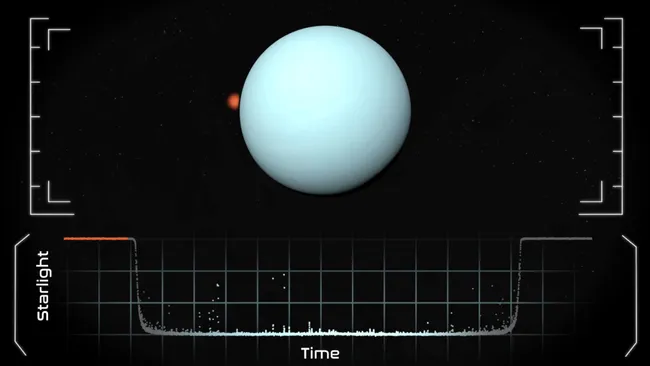Introduction:
 |
| Artist’s Illustration of Planetary Stellar Occultation: A Distant Star Eclipsed by Uranus (Image credit: NASA/Advanced Concepts Laboratory) |
This month, a rare astronomical event caught the attention of scientists and space enthusiasts alike. On April 7, 2025, Uranus, the coldest planet in our solar system, passed between Earth and a distant star, resulting in a stellar occultation. This event allowed NASA to gather valuable data about Uranus' atmosphere and rings, providing insights into the planet's stratosphere, atmospheric composition, and temperature changes. This blog post explores the significance of this rare occurrence, its implications for future space missions, and the exciting discoveries made during the occultation.
What is a Stellar Occultation?
A stellar occultation occurs when a celestial body, like a planet, passes in front of a distant star, blocking out its light. In this case, Uranus' passage between Earth and a star provided scientists with a unique opportunity to observe the ice giant in detail. These rare events are invaluable for studying planets that are otherwise difficult to analyze due to their distance and size.
NASA's Groundbreaking Research:
NASA’s research team, led by planetary scientists at NASA’s Langley Research Center, collaborated with an international group of over 30 astronomers. They used 18 observatories across North America to monitor the occultation. The last time a significant stellar occultation of Uranus occurred was in 1996, making this a rare and exciting event for researchers.
By analyzing the light curve — the change in brightness of the star as it was blocked — the team was able to study Uranus’ atmosphere in various layers. One key area of interest was the planet's stratosphere, the middle layer of its atmosphere. This new data will help scientists track the planet's atmospheric changes and improve their understanding of its weather systems and seasonal variations.
Key Findings and Discoveries:
- Atmospheric Composition and Temperature: The scientists measured the temperatures and composition of Uranus' stratosphere, noting significant changes since the last occultation. These findings could be vital for future missions to explore the planet more closely.
- Cloud Formation and Wind Patterns: The study of Uranus' atmosphere offers a glimpse into cloud formation, storm activity, and wind patterns. Without a solid surface to interfere with these processes, Uranus provides an ideal "atmospheric laboratory" for scientists to study these phenomena.
- Insights into Uranus' Ice Giant Nature: Uranus is classified as an "ice giant," composed largely of water, ammonia, and methane, with no solid surface. Studying the planet’s atmosphere helps researchers understand its complex atmospheric dynamics and how it differs from gas giants like Jupiter and Saturn.
Why This Matters for Future Exploration:
The data collected during this occultation provides crucial insights for future missions aimed at exploring Uranus. With its unique composition and extreme temperatures, Uranus presents challenges for spacecraft. The information gathered from this event will assist in designing better missions and instruments for exploring the ice giant, potentially paving the way for more detailed investigations in the coming years.
What’s Next?
Uranus is set to occult several dimmer stars over the next six years, offering further opportunities for research. The next significant stellar occultation of Uranus, involving an even brighter star, will occur in 2031. As we continue to improve our observational technology and techniques, future occultations will provide more detailed information about this fascinating planet.
Conclusion:
The April 2025 stellar occultation of Uranus was not only a rare astronomical event but also a monumental achievement in planetary science. By collaborating across observatories and nations, NASA and its international partners have expanded our knowledge of one of the most enigmatic planets in our solar system. As we look ahead to future occultations and exploration missions, the data gathered during this event will continue to shape our understanding of Uranus and its place in the broader context of the solar system.
Call to Action:
What do you think about this groundbreaking discovery? Join the conversation by leaving a comment below and sharing your thoughts on the implications of the Uranus occultation for future space exploration!



Post a Comment
0Comments